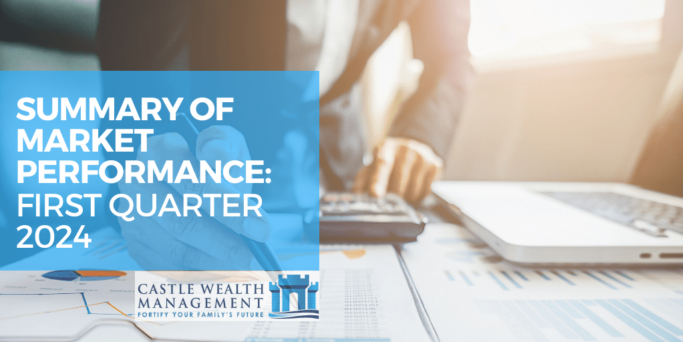U.S. Equity Investment Environment
U.S. equity markets registered strong gains once again despite the Federal Reserve leaving interest rates unchanged in March. The unemployment rate reached the highest level in two years in February at 3.9% but is still historically low. The S&P 500 recorded a 10.6% first quarter gain, setting a record-closing high, as the U.S. economy remains resilient and ongoing enthusiasm around Artificial Intelligence continues. The “Magnificent Seven” which led last year’s gains have been reduced to the “Fab Four” as Apple Inc., Alphabet Inc., and Tesla Inc. posted disappointing quarters. Tesla Inc. was the worst performing stock in the S&P 500, down 29.3% year to date. Despite this weakness, the Nasdaq 100 advanced 9.3%, while the Dow Jones Industrial Average gained 6.1%, helped by the addition of Amazon Inc. to its Index in February. All three major indices have recently traded at all-time highs but valuations for the Nasdaq 100 and the “Fab Four” have become especially stretched with price-to-earnings ratios of 27 and 35, respectively, compared to the Dow currently at 19. Communication services was the top performing sector with a 15.8% gain for the quarter, led by Meta Platforms Inc.’s 37.3% return. Real estate was the only negative sector this past quarter, down 0.6%, as policy easing is likely to be slower than previously expected. Small-capitalization issues underperformed with the S&P 600 posting a 2.5% return, while the S&P Midcap 400 gained 10.0%. Growth stocks continue to outpace value-oriented issues across all market capitalizations.
International Equity Environment
Foreign developed markets underperformed the U.S. with the MSCI EAFE Index rising 5.3% for the quarter. Central Banks in the U.K. and Europe kept rates unchanged as anticipated but are expected to commence rate cuts in the summer. Japanese stocks gained 11.0% in the first quarter as the Bank of Japan hiked rates for the first time since 2007, signaling an end to negative rates and yield curve control. The strength in Japanese markets was attributed to corporate earnings exceeding expectations as well as the Japanese Yen hitting a 34-year low against the U.S. Dollar in late March. Emerging markets returned a modest 2.4% gain for the MSCI Emerging Markets Index in Q1 in part due to China, the index’s largest component, which traded lower by 2.2% this past quarter. Foreign investors remain cautious amid ongoing fears about the outlook for the Chinese economy.
Fixed Income Environment
The Bloomberg U.S. Aggregate Bond Index dropped 0.8% in Q1 as resilient economic data and stickier inflation prints reigned-in market expectations for rate cuts. The Federal Reserve’s latest dot plot is still pricing in three rate cuts for 2024, although their timing is pushed back further in the year than previously anticipated. Interest-rate volatility persisted through-out the yield curve although the Federal Funds Rate remains at 5.25%-5.50%. U.S. Treasury yields across most maturities rose with the 10-year Treasury closing the quarter yielding 4.20%, up from 3.95% last quarter. The two-and-ten-year Treasury yield spread remains inverted at 0.39% and has persevered since the summer of 2022 without triggering a recession. In response to higher interest rates, long-dated Treasury bonds fell 3.3% this quarter and the Bloomberg Municipal Bond Index declined 0.4%.High-yield bonds performed best, finishing the quarter up 1.5%, benefitting most from increased optimism around potential risk factors, due to better economic growth data and strong demand from investors.
Commodities Environment
The S&P GSCI Index rallied 10.4% in the first quarter with all components of the index ending the period in positive territory. Energy led all commodity sectors, up 15.7% despite a sharp drop in natural gas prices, down 21.3% this past quarter. Gold performed well in part due to stubborn inflation data and continued central bank purchases, up 7.4% this quarter, breaking out of a multi-year range to all-time highs.

